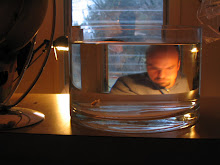Sunday, December 16, 2012
Practice makes pictures
She is such a person now. She has the quirky habits of a longtime roommate - she likes to eat, for instance, yogurt and honey on the coffee table, facing north - and she prefers Motown to metal. If you happen to give her your phone while you're driving, she can turn it on, open a fishing simulation game and catch a virtual catfish - or may take a photo, like the one above. When she wakes up (at about 5:30, of late), she turns on her bedroom light, and plays quietly with her doctor's kit and her dolls or experiments with her wardrobe. At 6 (and she knows it's 6 now; she can read digital clocks with some accuracy), she pads down the hall and wakes you up. Or, should you happen to get up before then, you might open the door to her room to find her smiling. In fact, the first words she said to me on Friday morning, after she'd gone to bed with a mild cold, were "Feeling better!"
In his book Outliers, Malcolm Gladwell discusses a study done by K. Anders Ericsson and two colleagues at the Berlin Academy of Music. Working with the school's violinists, whom they grouped in three broad categories according to skill level (world-class; good; proficient), the researchers asked the musicians how many hours, roughly, they had practiced since first picking up the instrument. Most of the violinists, they found, had begun playing at around 5 years of age. But by the age of 20, the world-class violinists had typically practiced an average of around 10,000 hours, in total, while the merely proficient had logged an average of 4,000 hours.
Even 4,000 sounds like a lot, right? Until you realize that Cleo, as an ordinary 3-and-a-half year-old, has already logged more than 36,000 hours of, well, of practice at simply being human. Speaking, running, taking pictures: it adds up, even for those of us who aren't outliers. And the results of such constant, steady practice are lovely.
Subscribe to:
Post Comments (Atom)





No comments:
Post a Comment